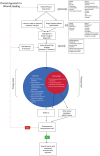Clinical recommendations and practical guide for negative pressure wound therapy with instillation
- PMID: 26011379
- PMCID: PMC7949544
- DOI: 10.1111/iwj.12452
Clinical recommendations and practical guide for negative pressure wound therapy with instillation
Abstract
Effective wound management involves a comprehensive assessment of the patient and the wound to determine an optimal wound treatment plan. It is critical to identify and address factors that may impair wound healing, prior to selecting the most appropriate therapy for each patient. Negative pressure wound therapy (NPWT) is a well-established advanced therapy that has been successful in adjunctive management of acute and chronic wounds. In recent years, the introduction of topical wound solution delivery in combination with NPWT has provided further benefits to wound healing. A commercially available system now offers automated, volumetric control of instilled topical wound solutions with a dwell time in combination with NPWT (NPWTi-d; V.A.C. VeraFlo Therapy, KCI, an Acelity company, San Antonio, TX). This NPWTi-d system differs from other instillation systems in that a timed, predetermined volume of topical wound solution is intermittently delivered (versus continuously fed) and allowed to dwell in the wound bed (without NPWT), for a user-selected period of time before NPWT is resumed. This added accuracy and process simplification of solution delivery in tandem with NPWT have prompted use of NPWTi-d as first-line therapy in a wider subset of complex wounds. However, considerably more research is required to validate efficacy of NPWTi-d in various wound types. The purpose of this review is to provide a relevant overview of wound healing, describe current literature supporting the adjunctive use of NPWTi-d, propose a clinical approach for appropriate application of NPWTi-d and conclude with case studies demonstrating successful use of NPWTi-d. Based on this review, we conclude that either a large case series examining effects of NPWTi-d on different wound types or possibly a large prospective registry evaluating NPWTi-d with real-world topical wound solutions versus immediate debridement and closure would be valuable to the medical community in evaluating the efficacy of this promising therapy.
Keywords: Dwell time; Instillation therapy; NPWTi-d; Negative pressure wound therapy; Wound healing.
© 2015 The Authors. International Wound Journal published by Medicalhelplines.com Inc and John Wiley & Sons Ltd.
Figures






References
-
- Riou JP, Cohen JR, Johnson H. Factors influencing wound dehiscence. Am J Surg 1992;163:324–30. - PubMed
-
- Abbas SM, Hill AG. Smoking is a major risk factor for wound dehiscence after midline abdominal incision; case–control study. ANZ J Surg 2009;79:247–50. - PubMed
-
- Ennis WJ, Valdes W, Salzman S, Fishman D, Meneses P. Trauma and wound care. In: Chronic wound care: a problem‐based learning approach, Morrison Moya J., Ovington Liza G., and Kay Wilkie. New York: Mosby, 2004:291–307.
-
- Rodeheaver GT. Pressure ulcer debridement and cleansing: a review of current literature. Ostomy Wound Manage 1999;45:80S–5. - PubMed
-
- Fernandez R, Griffiths R. Water for wound cleansing. Cochrane Database Syst Rev 2008;2:CD003861. - PubMed
Publication types
MeSH terms
LinkOut - more resources
Full Text Sources
Other Literature Sources

